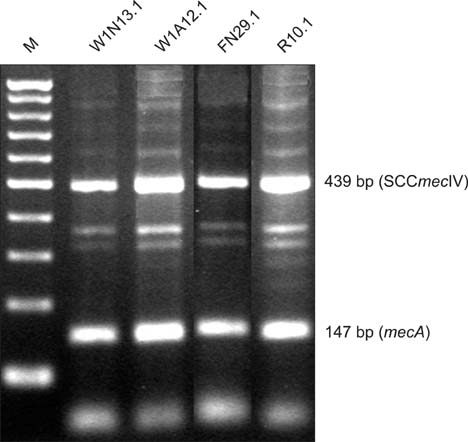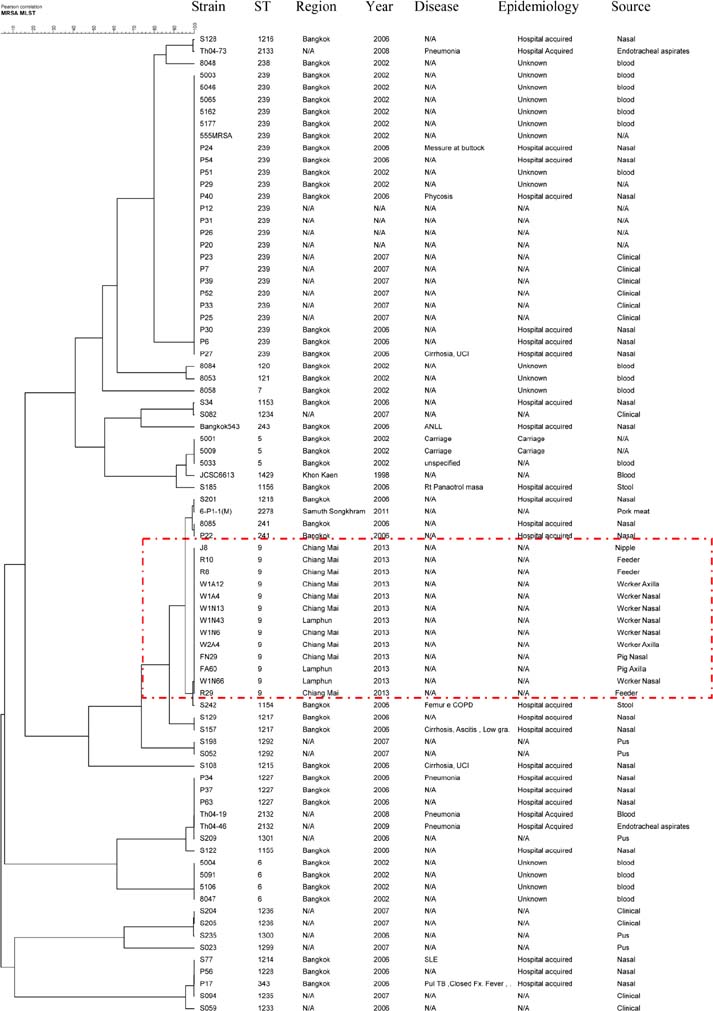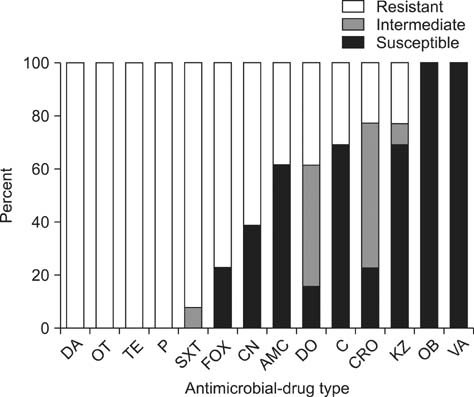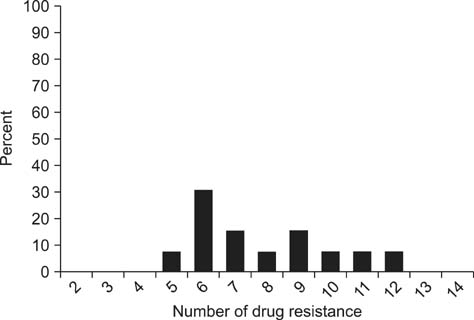J Vet Sci.
2014 Dec;15(4):529-536. 10.4142/jvs.2014.15.4.529.
Occurrence and characterization of livestock-associated methicillin-resistant Staphylococcus aureus in pig industries of northern Thailand
- Affiliations
-
- 1Department of Food Animal Clinic, Faculty of Veterinary Medicine, Chiang Mai University, Chiang Mai 50200, Thailand. patprapas@gmail.com
- 2Field Epidemiology Training Program, Ministry of Public Health, Nonthaburi 11000, Thailand.
- 3Veterinary Research and Development Center, Ministry of Agriculture and Cooperation, Bangkok 10200, Thailand.
- 4Johns Hopkins Center for a Livable Future, Johns Hopkins Bloomberg School of Public Health, Baltimore, MD 21205, USA.
- 5Bureau of Disease Control and Veterinary Services, Department of Livestock Development, Ministry of Agriculture and Cooperation, Bangkok 10200, Thailand.
- 6Department of Veterinary Medicine, Panel "Veterinary Public Health", Institute of Food Hygiene, Free University Berlin, Berlin 14195, Germany.
- 7Bureau of Epidemiology, Department of Disease Control, Ministry of Public Health, Nonthaburi 11000, Thailand.
- 8Department of Microbiology, Faculty of Medicine, Chiang Mai University, Chiang Mai 50200, Thailand.
- KMID: 2070239
- DOI: http://doi.org/10.4142/jvs.2014.15.4.529
Abstract
- This study was conducted to determine the prevalence of livestock-associated methicillin-resistant Staphylococcus aureus (LA-MRSA) in pigs, farm workers, and the environment in northern Thailand, and to assess LA-MRSA isolate phenotypic characteristics. One hundred and four pig farms were randomly selected from the 21,152 in Chiang Mai and Lamphun provinces in 2012. Nasal and skin swab samples were collected from pigs and farm workers. Environmental swabs (pig stable floor, faucet, and feeder) were also collected. MRSA was identified by conventional bacterial culture technique, with results confirmed by multiplex PCR and multi locus sequence typing (MLST). Herd prevalence of MRSA was 9.61% (10 of 104 farms). Among pigs, workers, and farm environments, prevalence was 0.68% (two of 292 samples), 2.53% (seven of 276 samples), and 1.28% (four of 312 samples), respectively. Thirteen MRSA isolates (seven from workers, four from environmental samples, and two from pigs) were identified as Staphylococcal chromosomal cassette mec IV sequences type 9. Antimicrobial sensitivity tests found 100% of the MRSA isolates resistant to clindamycin, oxytetracycline, and tetracycline, while 100% were susceptible to cloxacillin and vancomycin. All possessed a multidrug-resistant phenotype. This is the first evidence of an LA-MRSA interrelationship among pigs, workers, and the farm environment in Thailand.
Keyword
MeSH Terms
-
*Animal Husbandry
Animals
Cross-Sectional Studies
Genotype
Humans
Methicillin-Resistant Staphylococcus aureus/classification/*genetics/*isolation & purification
Microbial Sensitivity Tests/veterinary
Molecular Sequence Data
Multilocus Sequence Typing/veterinary
Multiplex Polymerase Chain Reaction/veterinary
Occupational Diseases/*epidemiology/microbiology
Phylogeny
Prevalence
Sequence Analysis, DNA/veterinary
Staphylococcal Infections/*epidemiology/microbiology
Swine
Swine Diseases/*epidemiology/microbiology
Thailand/epidemiology
Figure
Reference
-
1. Anukool U, O'Neill CE, Butr-Indr B, Hawkey PM, Gaze WH, Wellington EM. Meticillin-resistant Staphylococcus aureus in pigs from Thailand. Int J Antimicrob Agents. 2011; 38:86–87.2. Armand-Lefevre L, Ruimy R, Andremont A. Clonal comparison of Staphylococcus aureus isolates from healthy pig farmers, human controls, and pigs. Emerg Infect Dis. 2005; 11:711–714.
Article3. Broens EM, Graat EAM, Van Der Wolf PJ, Van De Giessen AW, De Jong MCM. Prevalence and risk factor analysis of livestock associated MRSA-positive pig herds in The Netherlands. Prev Vet Med. 2011; 102:41–49.
Article4. CLSI. CLSI document M02-A10. Performance Standards for Antimicrobial Disc Susceptibility Tests; Approved Standards. 10th ed. Wayne: Clinical and Laboratory Standards Institute;2009.5. Center for Plant and Life Sciences. Chelex DNA Extraction Method: Specialized Topics-Spring 2008. Creve Coeur: St. Louis Community College;2008.6. Cui S, Li J, Hu C, Jin S, Li F, Guo Y, Ran L, Ma Y. Isolation and characterization of methicillin-resistant Staphylococcus aureus from swine and workers in China. J Antimicrob Chemother. 2009; 64:680–683.
Article7. de Neeling AJ, van den Broek MJ, Spalburg EC, van Santen-Verheuvel MG, Dam-Deisz WDC, Boshuizen HC, van de Giessen AW, van Duijkeren E, Huijsdens XW. High prevalence of methicillin resistant Staphylococcus aureus in pigs. Vet Microbiol. 2007; 122:366–372.8. Enright MC, Day NP, Davies CE, Peacock SJ, Spratt BG. Multilocus sequence typing for characterization of methicillinresistant and methicillin-susceptible clones of Staphylococcus aureus. J Clin Microbiol. 2000; 38:1008–1015.
Article9. Frana TS, Beahm AR, Hanson BM, Kinyon JM, Layman LL, Karriker LA, Ramirez A, Smith TC. Isolation and characterization of methicillin-resistant Staphylococcus aureus from pork farms and visiting veterinary students. PLoS One. 2013; 8:e53738.
Article10. Graveland H, Wagenaar JA, Bergs K, Heesterbeek H, Heederik D. Persistence of livestock associated MRSA CC398 in humans is dependent on intensity of animal contact. PLoS One. 2011; 6:e16830.
Article11. Hanssen AM, Ericson Sollid JU. SCCmec in staphylococci: genes on the move. FEMS Immunol Med Microbiol. 2006; 46:8–20.12. Huber H, Koller S, Giezendanner N, Stephan R, Zweifel C. Prevalence and characteristics of meticillin-resistant Staphylococcus aureus in humans in contact with farm animals, in livestock, and in food of animal origin, Switzerland, 2009. Euro Surveill. 2010; 15:pii19542.13. Khanna T, Friendship R, Dewey C, Weese JS. Methicillin resistant Staphylococcus aureus colonization in pigs and pig farmers. Vet Microbiol. 2008; 128:298–303.
Article14. Larsen J, Imanishi M, Hinjoy S, Tharavichitkul P, Duangsong K, Davis MF, Nelson KE, Larsen AR, Skov RL. Methicillin-resistant Staphylococcus aureus ST9 in pigs in Thailand. PLoS One. 2012; 7:e31245.15. Lewis HC, Mølbak K, Reese C, Aarestrup FM, Selchau M, Sørum M, Skov RL. Pigs as source of methicillin-resistant Staphylococcus aureus CC398 infections in humans, Denmark. Emerg Infect Dis. 2008; 14:1383–1389.
Article16. Lim SK, Nam HM, Jang GC, Lee HS, Jung SC, Kwak HS. The first detection of methicillin-resistant Staphylococcus aureus ST398 in pigs in Korea. Vet Microbiol. 2012; 155:88–92.
Article17. Morcillo A, Castro B, Rodríguez-Álvarez C, González JC, Sierra A, Montesinos MI, Abreu R, Arias Á. Prevalence and characteristics of methicillin-resistant Staphylococcus aureus in pigs and pig workers in Tenerife, Spain. Foodborne Pathog Dis. 2012; 9:207–210.
Article18. Neela V, Mohd Zafrul A, Mariana NS, van Belkum A, Liew YK, Rad EG. Prevalence of ST9 methicillin-resistant Staphylococcus aureus among pigs and pig handlers in Malaysia. J Clin Microbiol. 2009; 47:4138–4140.
Article19. Robinson DA, Enright MC. Evolutionary models of the emergence of methicillin-resistant Staphylococcus aureus. Antimicrob Agents Chemother. 2003; 47:3926–3934.
Article20. Sergio DMB, Koh TH, Hsu LY, Ogden BE, Goh ALH, Chow PKH. Investigation of meticillin-resistant Staphylococcus aureus in pigs used for research. J Med Microbiol. 2007; 56:1107–1109.
Article21. Silbergeld EK, Davis M, Leibler JH, Peterson AE. One reservoir: redefining the community origins of antimicrobial-resistant infections. Med Clin North Am. 2008; 92:1391–1407.
Article22. Smith TC, Male MJ, Harper AL, Kroeger JS, Tinkler GP, Moritz ED, Capuano AW, Hermaldt LA, Diekema DJ. Methicillin-resistant Staphylococcus aureus (MRSA) strain ST398 is present in midwestern U.S. swine and swine workers. PLoS One. 2009; 4:e4258.23. Smith TC, Pearson N. The emergence of Staphylococcus aureus ST398. Vector Borne Zoonotic Dis. 2011; 11:327–339.24. Tenhagen BA, Fetsch A, Stührenderg B, Schleuter G, Guerra B, Hammerl JA, Hertwig S, Kowall J, Kämpe U, Schroeter A, Bräunig J, Käsbohrer A, Appel B. Prevalence of MRSA types in slaughter pigs in different German abattoirs. Vet Rec. 2009; 165:589–593.
Article25. Thrusfield M, Ortega C, de Blas I, Noordhuizen JP, Frankena K. WIN EPISCOPE 2.0: improved epidemiological software for veterinary medicine. Vet Rec. 2001; 148:567–572.
Article26. van Cleef BA, Verkade EJM, Wulf MW, Buiting AG, Voss A, Huijsdens XW, van Pelt W, Mulders MN, Kluytmans JA. Prevalence of livestock-associated MRSA in communities with high pig-densities in The Netherlands. PLoS One. 2010; 5:e9385.
Article27. Vanderhaeghen W, Hermans K, Haesebrouck F, Butaye P. Methicillin-resistant Staphylococcus aureus (MRSA) in food production animals. Epidemiol Infect. 2010; 138:606–625.
Article28. Vestergaard M, Cavaco LM, Sirichote P, Unahalekhaka A, Dangsakul W, Svendsen CA, Aarestrup FM, Hendriksen RS. SCCmec type IX element in methicillin resistant Staphylococcus aureus spa type t337 (CC9) isolated from pigs and pork in Thailand. Front Microbiol. 2012; 3:103.29. Voss A, Loeffen F, Bakker J, Klaassen C, Wulf M. Methicillin-resistant Staphylococcus aureus in pig farming. Emerg Infect Dis. 2005; 11:1965–1966.30. Wertheim HFL, Melles DC, Vos MC, van Leeuwen W, van Belkum A, Verbrugh HA, Nouwen JL. The role of nasal carriage in Staphylococcus aureus infections. Lancet Infect Dis. 2005; 5:751–762.31. Wulf MW, Sørum M, van Nes A, Skov R, Melchers WJ, Klaassen CH, Voss A. Prevalence of methicillin-resistant Staphylococcus aureus among veterinarians: an international study. Clin Microbiol Infect. 2008; 14:29–34.
Article32. Zhang K, McClure JA, Elsayed S, Louie T, Conly JM. Novel multiplex PCR assay for characterization and concomitant subtyping of staphylococcal cassette chromosome mec types I to V in methicillin-resistant Staphylococcus aureus. J Clin Microbiol. 2005; 43:5026–5033.
Article
- Full Text Links
- Actions
-
Cited
- CITED
-
- Close
- Share
- Similar articles
-
- Detection of Multidrug Resistant Patterns and Associated - genes of Methicillin Resistant Staphylococcus aureus ( MRSA ) Isolated from Clinical Specimens
- A statistical analysis of methicillin-resistant staphylococcus aureus
- A case of multiple furunculosis caused by methicillin-resistant staphylococcs aureus
- Community-associated methicillin-resistant Staphylococcus aureus (CA-MRSA)
- Prevalence and characteristics of livestock-associated methicillin-susceptible Staphylococcus aureus in the pork production chain in Korea





